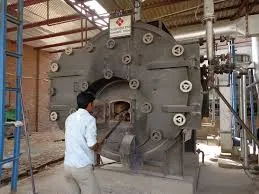
Қар . 30, 2024 21:33 Back to list
types of steam in boiler
Types of Steam in Boilers
Steam generation is a critical process in various industrial applications, including power generation, heating, and manufacturing. Boilers play a vital role in this process, as they are responsible for converting water into steam through the application of heat. The characteristics of the steam produced can vary significantly, depending on the design and operation of the boiler. Understanding the different types of steam generated in boilers is essential for optimizing performance and ensuring safety.
1. Saturated Steam
Saturated steam is one of the most common types generated in boilers. It is defined as steam that is in equilibrium with liquid water at a specific pressure and temperature. This means that any heat added to saturated steam will turn it into superheated steam without an increase in pressure. Conversely, if heat is removed from it, the steam will condense back into water. Saturated steam is widely utilized in various applications, particularly in heating systems, because it can transfer heat efficiently while maintaining a stable pressure and temperature.
Superheated steam is steam that has been heated beyond its saturation point at a given pressure. This process is achieved by passing the saturated steam through additional heating surfaces within the boiler. The advantage of superheated steam is that it possesses higher energy content per unit mass, which makes it particularly useful for applications that require high energy transfer, such as in steam turbines for electricity generation. Because superheated steam is less likely to condense during transportation, it can lead to increased efficiency and reduced piping issues.
3. Dry Steam
types of steam in boiler

Dry steam is a specific condition of saturated steam that contains no liquid water droplets. It is crucial in processes where the presence of water can cause damage or inefficiencies, such as in turbines. To achieve dry steam, proper boiler design and operation must be maintained, including adequate steam separation and avoiding carryover of water. Dry steam is preferable in applications where the steam must move through a system without losing heat or pressure due to moisture.
4. Wet Steam
Wet steam is a mixture of steam and water droplets. It typically occurs when the steam is generated at a temperature and pressure that allows some of the water to remain in vapor form. Wet steam is less desirable in most applications because the water content can lead to steam quality issues, reduced efficiency, and even damage to equipment like turbines. However, in some specific heating applications, wet steam can still be utilized effectively.
Conclusion
In summary, the types of steam produced in boilers—saturated steam, superheated steam, dry steam, and wet steam—serve different functions depending on the requirements of the application. Each type has its advantages and disadvantages that can impact thermal efficiency, equipment longevity, and overall system performance. Understanding these types allows operators to make informed decisions about boiler design, operation, and maintenance, ensuring optimal steam generation for industrial needs. By doing so, they can enhance productivity while maintaining safety and efficiency in their operations.
As technology progresses, advancements in boiler design and steam production techniques will continue to evolve, offering even better solutions for steam generation and management in various industries. This evolution emphasizes the importance of staying informed about the types of steam and their implications for system optimization.
-
Efficient Biomass Fired Hot Water Boiler | AI Heating Solution
NewsAug.01,2025
-
High-Efficiency Gas Thermal Oil Boilers | HPT Models
NewsJul.31,2025
-
Oil Fired Hot Water Boilers Sale - High Efficiency & Affordable
NewsJul.31,2025
-
High-Efficiency Commercial Oil Fired Steam Boiler for Industry
NewsJul.30,2025
-
High-Efficiency Biomass Fired Thermal Oil Boiler Solutions
NewsJul.30,2025
-
High Efficiency Gas Fired Thermal Oil Boiler for Industrial Heating
NewsJul.29,2025
Related PRODUCTS






















